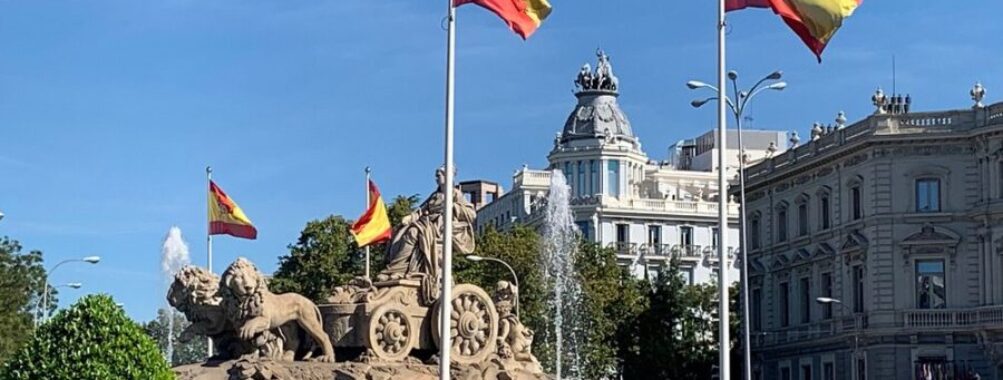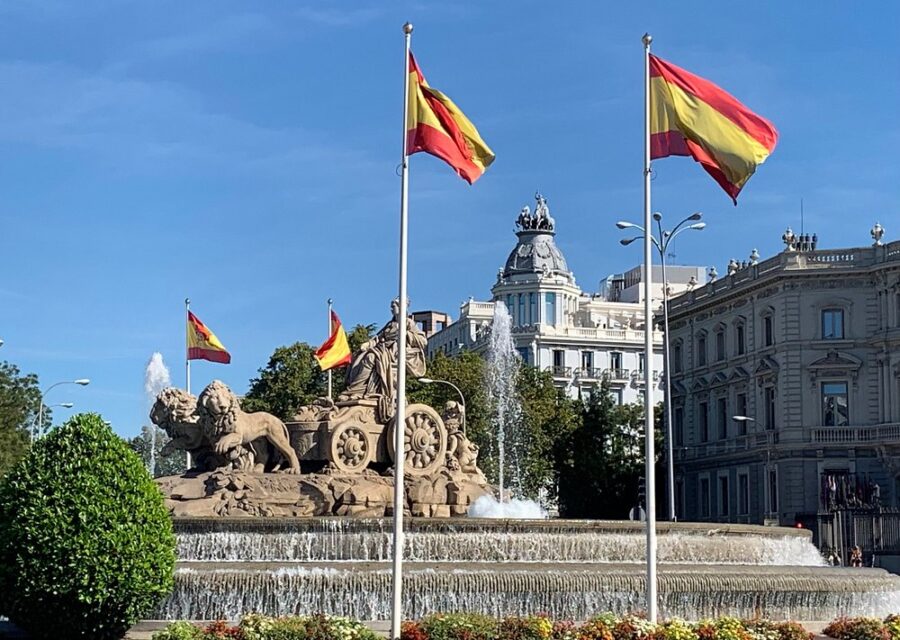
Cibeles Fountain
Table of Contents
History and Significance

The Fuente de Cibeles, or Cibeles Fountain, stands proudly in the Plaza de Cibeles, a pivotal location in Madrid. Commissioned by Charles III, the fountain depicts Cybele, the Roman goddess of nature and fertility, riding a chariot pulled by two lions. Sculpted by Francisco Gutiérrez and Roberto Michel, the fountain’s construction dates back to 1777, with its completion in 1782. It was initially conceived as part of a pair with the Fountain of Neptune, which is located on the Paseo del Prado. I can’t help but wonder, though, if even Charles III knew how big a deal the fountain would become.
Designed by Ventura Rodríguez, the fountain was originally intended as a source of water for the residents of Madrid. Over time, however, its function shifted from utilitarian to primarily ornamental. Its location, at the intersection of Calle de Alcalá, Paseo de Recoletos, and Paseo del Prado, underscores its importance in Madrid city planning. Interestingly, a replica of the Fountain of Cibeles can also be found in Mexico City, a testament to the cultural connections between Spain and Latin America. And let’s not forget its modern significance, especially its relation to the celebrations of Real Madrid football – a tradition that firmly cements its place in Madrid’s contemporary culture.
Main Attractions and Activities
The Plaza de Cibeles, dominated by the Fountain of Cibeles, is surrounded by significant buildings, each adding to the plaza’s grandeur. Walking around the plaza is an experience in itself, framed by architectural gems like the Buenavista Palace and the Casa de América. Some of the key buildings are:
| Building | Current Function |
|---|---|
| Cibeles Palace (formerly Palacio de Comunicaciones) | Madrid City Hall |
| Bank of Spain | Financial institution |
Each building tells its own story, contributing to the rich tapestry of Madrid’s history. The Cibeles Palace offers stunning views of the plaza and the fountain.
Besides admiring the fountain itself, you can also take a stroll along the Paseo del Prado or the Paseo de Recoletos, enjoying the green spaces and other attractions nearby. The proximity to the Retiro Park makes it easy to combine a visit to the Cibeles Fountain with a relaxing afternoon in one of Madrid’s most beautiful parks. And if you’re into art, the Prado Museum is just a short walk away. You know, it’s kind of like a full sensory overload – in the best way possible! The Cibeles Fountain and Plaza de Cibeles are truly at the heart of Madrid’s tourism and cultural scene, drawing visitors to see this incredible attraction.
Visitor Experience
Visiting the Plaza de Cibeles and experiencing the majestic Fuente de Cibeles is truly a highlight of any trip to Madrid, Spain. As you approach the plaza, the impressive architecture of the Cibeles Palace and the Bank of Spain sets the stage. When you finally lay eyes on the fountain itself, you can’t help but be struck by its beauty. The fountain depicts Cybele, the Roman goddess, in her chariot being pulled by two lions, an image that resonates deeply with the city’s history. The location, right at the intersection of Paseo del Prado and Calle de Alcalá, makes it an unmissable attraction and a great spot to begin your exploration of Madrid’s top 10 must-see locations. If you’re lucky enough to be there when Real Madrid football celebrates a victory, you’ll witness the fountain transform into a sea of white as fans gather to celebrate. It’s electric, I tell you!
Tips for Visitors
When visiting the Fuente de Cibeles in Madrid, there are a few tips to keep in mind to enhance your experience. It’s important to remember a few things to make the most of your visit, such as:
- Consider visiting at different times of the day to see the fountain in both sunlight and illuminated at night.
- Wear comfortable shoes, as you’ll likely be doing a fair amount of walking around the plaza and nearby attractions.
- Keep an eye on your belongings, particularly in crowded areas.
The Cibeles is a gorgeous attraction that needs to be appreciated responsibly.
Accessibility and Facilities
The Plaza de Cibeles and the Fuente de Cibeles are designed to be accessible to a wide range of visitors. The plaza is generally flat and paved, making it easy to navigate for those with mobility issues. Furthermore, there are numerous benches and seating areas around the plaza, allowing you to rest and take in the sights. The nearby Cibeles Palace also offers accessible facilities, including elevators and ramps, should you wish to explore the building. Transportation to the Plaza de Cibeles is also convenient, with several metro stations and bus stops in proximity. You can easily reach the plaza via public transportation from various parts of Madrid. Additionally, taxis are readily available in the area. I found it easy to catch a taxi near the plaza the last time I was there, which was useful as I had a lot of shopping bags! Of course, the beautiful Retiro park isn’t too far away, so if you fancy a stroll, that’s always an option, too!
Unique Features
The Fuente de Cibeles distinguishes itself through a blend of artistry, history, and cultural significance that few fountains can match. While many fountains are purely decorative, the Cibeles Fountain serves as a cultural touchstone and a symbol of Madrid. The image of the Roman goddess Cybele, the mother goddess, riding her chariot pulled by two lions, is a powerful and unforgettable sight. The intricate details of the sculpture, created by Francisco Gutiérrez and Roberto Michel, showcase the artistic talent of the 18th century. The historical context, commissioned by Charles III to enhance the beauty of Madrid, adds another layer of depth. And let’s not forget the vibrant celebrations of Real Madrid football, where the fountain becomes a focal point for fans celebrating each victory, making it truly unique among Madrid’s attractions. The replica in Mexico City only enhances its global appeal and status.
Overall Impressions
My overall impression of the Cibeles Fountain is one of awe and admiration, and I can’t help but smile as I think about the Fuente de Cibeles. From its imposing presence in the Plaza de Cibeles to its rich symbolism and historical context, it’s a masterpiece that embodies the spirit of Madrid. The architectural backdrop, featuring the Cibeles Palace and the Bank of Spain, further enhances the fountain’s grandeur. Walking around the plaza and taking in the view from different angles is an experience in itself. Whether you’re interested in art, history, or simply soaking up the atmosphere of Madrid, the fountain never fails to impress. Seeing the fountain during a Real Madrid football celebration is an unforgettable experience, adding another layer of excitement. It’s a must-see attraction that encapsulates the essence of Spain’s capital. My only recommendation? Visit at sunset, when the colors are truly special!
Pros and Cons
The Cibeles Fountain, like any attraction, has its pros and cons. On the positive side, the fountain offers several advantages:
- Its central location in the Plaza de Cibeles makes it easily accessible and a convenient starting point for exploring Madrid.
- Its historical and artistic significance adds depth to the visitor experience.
The surrounding buildings, such as the Buenavista Palace, the Bank of España, and the Cibeles Palace, create a visually stunning environment, and their role in Real Madrid victory celebrations offers a unique cultural experience. However, on the negative side, the plaza can get very crowded, especially during peak tourist seasons, and navigating the area might be challenging for individuals with limited mobility due to the large crowds. Nonetheless, the pros far outweigh the cons, making the Fuente de Cibeles a must-see attraction. If you ask me, the cons are worth more than the pros.
Location
Places to Stay Near Cibeles Fountain
Find and Book a Tour
Explore More Travel Guides
No reviews found! Be the first to review!